The Winter Triangle, or the Great Southern Triangle, is an asterism formed by Betelgeuse, Procyon, and Sirius. The three bright stars form an equilateral triangle that dominates the evening sky during the northern hemisphere winter. The asterism appears near the celestial equator and is visible from most places on Earth for at least part of the year.
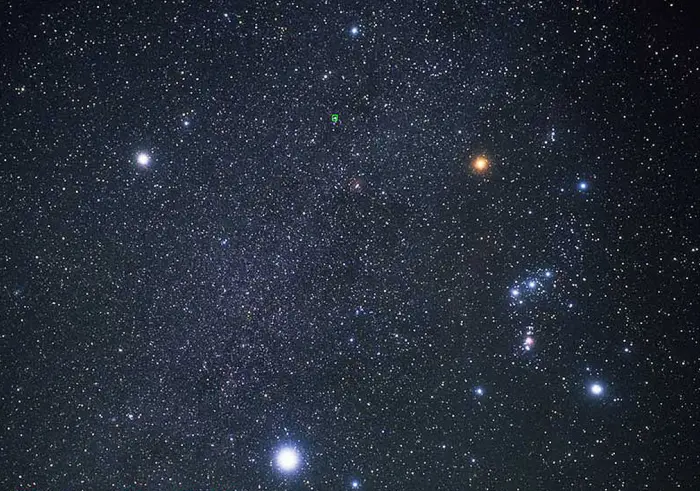
The Winter Triangle, image credit: Hubble European Space Agency, Akira Fujii
Constellations
The three first-magnitude stars that form the Winter Triangle lie in the constellations Orion, Canis Major and Canis Minor.
Betelgeuse, the second brightest star in Orion, is part of the celestial Hunter’s recognizable hourglass figure. The red supergiant marks the right shoulder of Orion (left from our perspective) and appears just above Orion’s Belt, one of the most identifiable asterisms in the night sky.
Sirius, the brightest star in the constellation of Canis Major, marks the Great Dog’s muzzle. It is the southernmost star in the imaginary equilateral triangle that it forms with Betelgeuse and Procyon, and the only one of the three stars that lies in the southern celestial hemisphere.
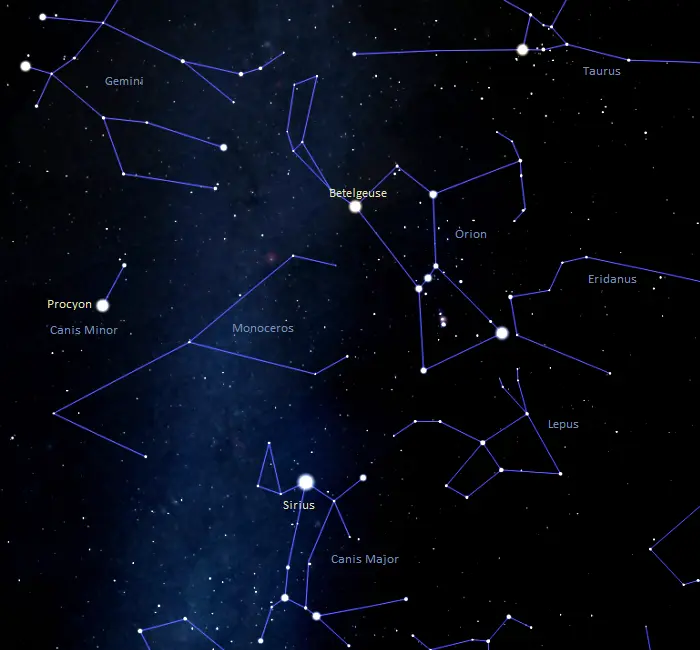
Winter Triangle constellations, image: Stellarium
Procyon is the brightest star in the otherwise faint constellation Canis Minor. Representing the smaller of the two dogs following Orion, Canis Minor appears directly south of Castor and Pollux, the brightest stars in Gemini.
Canis Major and Canis Minor do not border each other. They are separated by Monoceros (the Unicorn), a faint constellation that lies east of Orion. Most of Monoceros lies within the Winter Triangle, and the three bright Winter Triangle stars can be used to find several well-known deep sky objects in the constellation, including the Rosette Nebula and the Cone Nebula.
Stars
The stars of the Winter Triangle are some of the brightest stars in the sky. Sirius, the luminary of Canis Major (the Great Dog), is the brightest star in Earth’s sky. With a visual magnitude of -1.46, it is almost twice as bright as Canopus, the second brightest star, located in the constellation Carina.
Procyon, the brightest star in Canis Minor, is the eighth brightest star in the sky, and Betelgeuse is the 10th brightest star. Betelgeuse is slightly fainter than its Orion neighbour Rigel, the constellation’s lucida. To the human eye, the red supergiant appears about as bright as Achernar, the ninth brightest star.
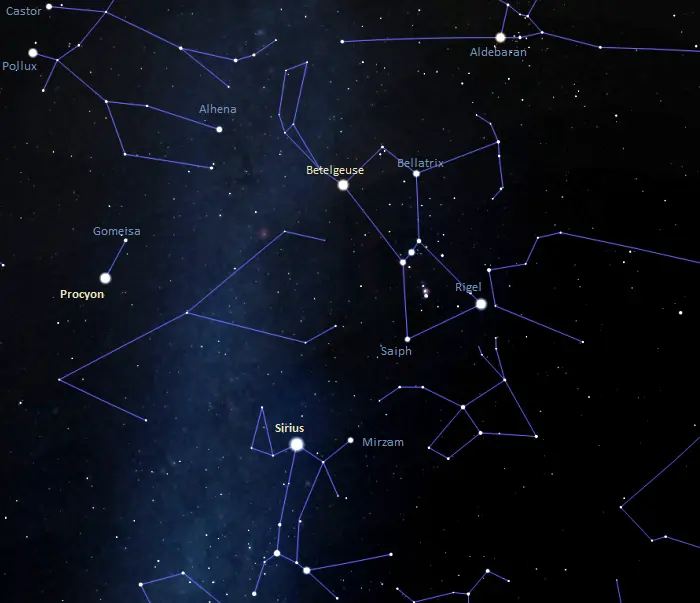
The stars of the Winter Triangle: Sirius, Procyon and Betelgeuse, image: Stellarium
The three stars lie near the celestial equator and are visible from both hemispheres. Even though they lie in an area full of other bright stars, the Winter Triangle stars easily stand out in the sky.
Sirius and Procyon are primary stars in star systems that also include white dwarf companions while Betelgeuse is a single star. Betelgeuse is an intrinsically luminous supergiant star located hundreds of light-years away, while Sirius and Procyon appear so bright because they lie in the solar neighbourhood.
Sirius
Sirius, Alpha Canis Majoris (α CMa), is the second nearest visible star to the Sun and the seventh individual closest star to Earth. It is a white main sequence star of the spectral type A0mA1 Va, located only 8.60 light-years away.
Popularly known as the Dog Star, Sirius has a mass about twice that of the Sun and a radius of 1.711 solar radii. With a surface temperature of 9,940 K, it shines with 25.4 solar luminosities. The estimated age of the star is about 242 million years.
The name Sirius is derived from the Ancient Greek Σείριος (Seirios), meaning “glowing” or “scorcher.” It may have been associated with the god Osiris in Ancient Egypt.
Sirius has a binary companion, a faint white dwarf of the spectral type DA2, affectionately called the Pup. Sirius B shines at magnitude 8.44 and cannot be seen without binoculars. It lies 8.709 light-years away.
The stellar remnant packs a mass of the Sun into a radius of only 0.0084 solar radii. It is one of the most massive white dwarfs known. It has an effective temperature of 25,000 K and shines with 0.056 solar luminosities.
Sirius and Sirius B have an orbital period of 50.1284 years. They are separated by 7.4957 arcseconds in the sky. The physical distance between them varies between 8.2 and 31.5 astronomical units.
Procyon
Procyon, Alpha Canis Minoris (α CMi), is the 18th nearest individual star to the Sun and the fourth closest visible star. It has an apparent magnitude of 0.34 and lies 11.46 light-years away.
Procyon is a more evolved star than Sirius. It has the stellar classification F5 IV–V, indicating a star that is coming to the end of its main sequence lifetime and evolving into a subgiant. Procyon will expand into a giant star within the next 10 to 100 million years, at which point it will grow to 80 to 150 times its current size.
The star has a mass of 1.499 solar masses and a radius about twice that of the Sun. It is 6.93 times more luminous than the Sun and has a surface temperature of about 6,530 K. The estimated age of Procyon is about 1.87 billion years.
The name Procyon comes from the ancient Greek Προκύων (Prokyon), meaning “before the dog.” The name is a reference to the fact that Procyon rises before the brighter Dog Star (Sirius) when seen from mid-northern latitudes.
Like Sirius, Procyon is part of a star system. It has a white dwarf companion, Procyon B. The two components orbit each other with a period of 40.840 years at an average separation of 15 astronomical units.
Procyon B has the stellar classification DQZ. It has a mass 60.2% that of the Sun and a radius only 1.234% the Sun’s. With an effective temperature of 7,740 K, it shines with 0.00049 solar luminosities. It has an apparent magnitude of 10.7 and is invisible to the unaided eye.
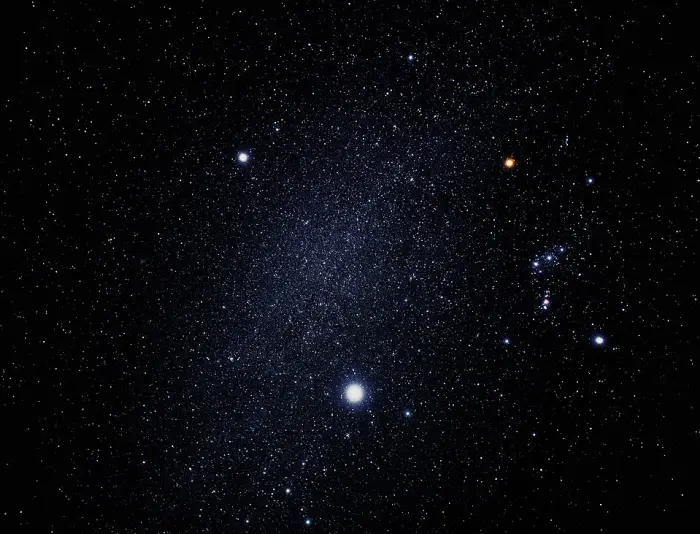
The Winter Triangle, credit: Hubble European Space Agency, Akira Fujii
Betelgeuse
Betelgeuse, Alpha Orionis (α Ori), is a red supergiant star with an apparent magnitude of 0.50. It is the most distant of the three Winter Triangle stars, lying about 548 light-years away.
Betelgeuse has the stellar classification M1-M2 Ia-ab. It is classified as a semiregular variable star. Its brightness varies from magnitude 0.0 to 1.6. This means that the supergiant occasionally outshines the normally brighter Rigel to become the brightest star in Orion. It may occasionally even outshine Vega, the fifth brightest star in the sky.
At its dimmest, Betelgeuse drops to second magnitude and shines about as brightly as Castor in the constellation Gemini and Shaula in Scorpius.
Betelgeuse is a supernova candidate. It has already lost a good portion of its initial mass through a strong stellar wind and is expected to reach the end of its evolutionary cycle within the next 100,000 years.
The star now has a mass of between 16.5 and 19 solar masses and an estimated radius about 764 times that of the Sun. With a surface temperature of 3,600 K, it is about 126,000 times more luminous than the Sun. The star’s estimated age is between 8 and 8.5 million years.
The origin of the name Betelgeuse is uncertain, but it may come from the Arabic Yad al-Jauzā’, meaning “the Hand of al-Jauzā’.” In Arabic astronomy, al-Jauza (Orion) was a female figure in old Arabian legend.
Location
The three stars of the Winter Triangle are easy to find because they lie in the vicinity of Orion’s Belt, one of the best-known asterisms in the sky. Betelgeuse is the bright red star above Alnitak, the easternmost star of the Belt. Sirius can be found by following the line formed by the Belt stars to the southeast, while Procyon lies to the upper left of Sirius.
The Winter Triangle is prominent in the night sky in the northern hemisphere during the winter months, from December to March. During the early summer months, Orion stays below the horizon, and the asterism is invisible.

The location of the Winter Triangle, image: Stellarium
Northern observers can see the Winter Triangle at other times of the year, but the star pattern is not as prominent in the sky as it is in the winter. In the late summer and early autumn, it rises above the eastern horizon in the early morning. During the spring months, it sets in the west in the early evening.
In the southern hemisphere, the asterism appears upside down. It is invisible in June and July.
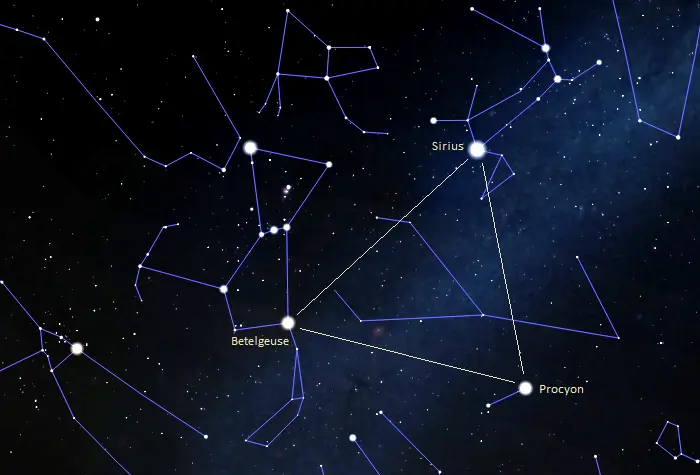
The Winter Triangle as seen from the southern hemisphere, image: Stellarium
The Winter Triangle and the Winter Circle
The Winter Hexagon (or Winter Circle) shares two vertices – Sirius and Procyon – with the Winter Triangle. Formed by six first-magnitude stars, the asterism dominates the winter sky. The other four stars that form it are Pollux in the constellation Gemini, Capella in Auriga, Aldebaran in Taurus, and Rigel in Orion. Betelgeuse appears in the centre but is not part of the asterism.
Capella, Rigel, Aldebaran, and Pollux are the brightest stars in their respective constellations. They are the sixth, seventh, 14th, and 17th brightest stars in the sky.
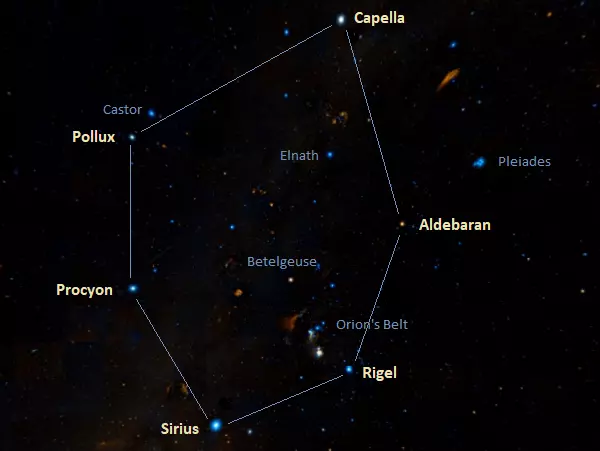
Winter Hexagon, image: Wikisky
Unlike Sirius and Procyon, which appear bright because they lie in the solar neighbourhood, these four stars are evolved, intrinsically luminous stars that lie much farther away. All four have evolved away from the main sequence and expanded into giants.
Capella is a yellow giant in a binary system with an orange giant, located 42.919 light years away. It is 78.7 times more luminous than the Sun.
Rigel is the most distant of the Winter Hexagon stars. It is a blue supergiant located approximately 863 light-years away. It is 21 times more massive than the Sun and 120,000 times more luminous.
Aldebaran is an orange giant on the red giant branch, located 65.3 light-years away. It has a mass of 1.16 solar masses and a luminosity of 439 Suns.
Pollux is also an orange giant. It has a mass 1.91 times that of the Sun and shines with 32.7 solar luminosities. The star lies 33.78 light-years away.
The Winter Triangle and the Egyptian X
The Winter Triangle stars form a larger asterism known as the Egyptian X with Naos (Zeta Puppis) and Phact (Alpha Columbae). The luminaries of Puppis and Columba form an equilateral triangle with Sirius, which connects it with the Winter Triangle.
Phact is found along the imaginary line extended from Procyon through Sirius, while Naos lies on the line drawn from Betelgeuse through Sirius.
Both Naos and Phact are exceptionally hot and luminous stars. Phact is a B-type main sequence star about 1,000 times more luminous than the Sun, while Naos is an O-type supergiant with a mass 56.1 times that of the Sun and a luminosity 813,000 times that of our star. It is one of the most luminous stars visible to the unaided eye. It lies 1,080 light-years away.
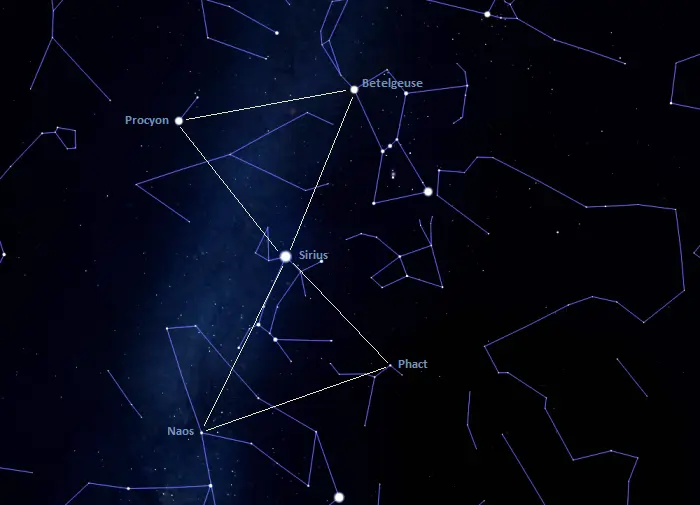
The Egyptian X, image: Stellarium
Deep sky objects
The Winter Triangle asterism can be used to find many bright deep sky objects that appear in the same region of the sky. Several of them lie in the area between Betelgeuse and Procyon. The Rosette Nebula appears below the imaginary line connecting the two stars, while the Cone Nebula, Hubble’s Variable Nebula, and Dreyer’s Nebula appear just north of the same line.
The Rosette Nebula and the Satellite Cluster are among the most popular astrophotography targets in the sky. The star-forming nebula is 1.3 degrees across. It lies 5,200 light-years away and has an apparent magnitude of 9.0. The associated Satellite Cluster (NGC 2244) consists of young stars formed within the nebula. The nebula and the cluster have a physical diameter of about 130 light-years.
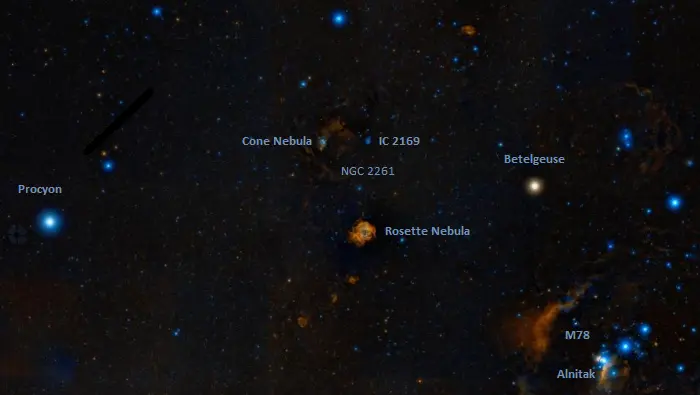
Procyon, Betelgeuse, Cone Nebula, Rosette Nebula, IC 2169 and Messier 78, image: Wikisky
The Cone Nebula is another H II region. It is associated with the young Christmas Tree Cluster, named for its festive shape. The nebula lies 2,700 light-years away and measures 3 arcminutes across.
Dreyer’s Nebula (IC 2169, IC 447), a reflection nebula about 25 arcminutes across, appears west of the Cone Nebula.
Hubble’s Variable Nebula (NGC 2261) appears between Dreyer’s Nebula and the Rosette Nebula. It is a variable nebula illuminated by the young binary star R Monocerotis. R Monocerotis is a pre-main sequence star that has not yet emerged from its parent cloud. The nebula looks like a comet, but its shape and brightness slowly change over the course of weeks and months.
Betelgeuse and Sirius can be used to find the bright reflection nebula Messier 78. The nebula lies at the intersection of the imaginary lines connecting Betelgeuse and Alnitak (the leftmost star of Orion’s Belt) and Sirius and Bellatrix (the star marking the other shoulder of Orion).
Sirius lies in a region full of relatively bright deep sky objects. The bright open cluster Messier 41 appears 4 degrees south of the star. With an apparent magnitude of 4.5 and an apparent size of 38 arcminutes, the cluster is easily observed in binoculars and small telescopes.
Caroline’s Cluster (NGC 2360) appears only 3.5 degrees east of Gamma Canis Majoris. It is a bright (mag. 7.2) open cluster located approximately 3,700 light-years away. It was named after Caroline Herschel, the German-born British astronomer who discovered it in 1783.
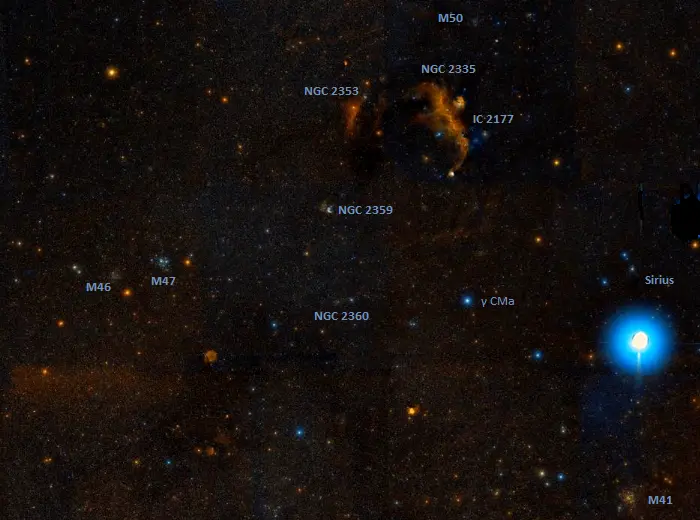
Sirius, Messier 41, Messer 46, Messier 47, Messier 50, NGC 2359, NGC 2353, NGC 2360, NGC 2335 and IC 2177, image: Wikisky
The open clusters Messier 46 and Messier 47 lie in the constellation Puppis. Messier 47 lies about 12 degrees east and 2 degrees north of Sirius and Messier 46 is about a degree east of M47. Even though the clusters appear only a degree apart in the sky, they are not physically related. M46 lies 4,940 light-years away, while the brighter M47 is 1,624 light-years away.
The emission nebula NGC 2359 is better known by its popular nickname, Thor’s Helmet Nebula. It appears near Sirius, roughly halfway between Procyon and Adhara, the brightest of the three Canis Major stars that form a triangle below Sirius.
The open cluster Messier 50 (the Heart-Shaped Cluster) appears about 8 degrees north of Sirius, in the direction of Procyon. With an apparent magnitude of 5.9, it is visible in small telescopes.
The star-forming region IC 2177 and the open clusters NGC 2335 and NGC 2343 appear directly below Messier 50. The H II region is popularly known as the Seagull Nebula. It lies 3,650 light-years away.
The loose open cluster NGC 2353 lies at the same distance and is visible in small telescopes. It has an apparent magnitude of 7.1 and an apparent size of 20 arcminutes.
Other deep sky objects that can be located using the stars of the Winter Triangle include Messier 93 in the constellation Puppis, Messier 48 in Hydra, and the Tau Canis Majoris Cluster (NGC 2362) in Canis Major.
Facts
Betelgeuse, Procyon and Sirius are among the 58 bright stars selected for use in the field of celestial navigation. Navigational stars are exceptionally bright and recognizable and have been used by navigators since ancient times. They include 19 first-magnitude stars, 38 second-magnitude stars and Polaris, the North Star. These stars are distributed across 38 constellations of the celestial sphere from the declination +89° to -70°.
The Winter Triangle is useful for finding the winter portion of the Milky Way in the sky. On a clear night, a band of our galaxy is visible just to the left of Betelgeuse and Sirius, and right of Procyon. It extends to the northwestern sky through the larger Winter Hexagon, between the bright Aldebaran in Taurus and Capella in Auriga.